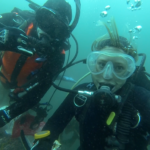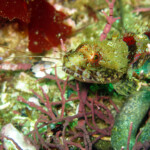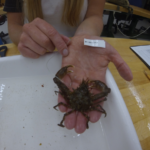Spatial Variation of Invertebrate Survival in Central California Kelp Forests
A Thesis Defense by Devona Yates
December 8th, 2017
MLML Seminar Room
Devona graduated from the University of California Santa Cruz (UCSC) in 2008 with a B.S. in Marine Biology. Before coming to Moss Landing Marine Laboratories in 2012, Devona spent four years as a scientific diver for the Partnership for Interdisciplinary Studies of Coastal Oceans (PISCO) at University of California Santa Cruz, a long-term ecosystem research and monitoring program whichconducts research in nearshore oceanography, ecological interactions, population replenishment (recruitment), population genetics, and the diversity and structure of ecological communities in central-northern California kelp forests. As an undergraduate, Devona was an assistant research diver under the supervision of PhD candidate Jan Freiwald and Dr. Mark H. Carr (UCSC), where she used acoustic telemetry and SCUBA surveys to study the movement and homerange size of temperate reef fishes, and aided in the development of microsatellite markers for a parentage analysis on adult kelp greenling (Hexagrammos decagrammus)1. Devona’s extensive amount of time spent underwater observing kelp forest organisms and their natural habitats with PISCO (over 600 coldwater dives), combined with her interest in population and community ecology led her focus of her Masters thesis on predator- prey interactions and the cascading effects of fish predation on lower trophic level organisms. This research will use tethering experiments and underwater habitat surveys in order to quantify mortality rates of invertebrate prey as a function of MPA protection status and habitat type along the Monterey Peninsula.
Thesis Abstract:
Human induced shifts in predator abundances are well documented in ecosystems all over the globe, yet the extent to which predators regulate prey populations in marine ecosystems is not fully understood. Marine reserves, a type of no-take Marine Protected Area, are effective at allowing fish populations to reestablish inside their boundaries. Since individuals targeted by fishing tend to be larger and occur at higher trophic levels, the establishment of marine reserves often results in an increase in predatory fish, and the potential to impact populations of their prey via consumptive and non-consumptive effects. In 2007, several new reserves were added to two existing marine reserves (30+ years protection) in central California, creating a network of marine reserves that prohibiting fishing. Knowledge on the recovery of predatory fishes inside these reserves and their potential effects on invertebrate prey are not well understood. By conducting field surveys and empirical predation assays (i.e., tethering experiments) inside and outside of marine reserves, I provide new evidence detailing the direct and indirect effects of changes in predator abundance for kelp forest communities. Densities of invertebrate predator fishes (i.e., invertivores) were 1.5x higher and biomass was 2.8x greater inside no-take marine reserves compared to nearby areas open to fishing. The increased abundance of predators translated to a significant reduction in survivorship of two species of decapod crustaceans, the coonstripe or dock shrimp, Pandalus danae, and the cryptic kelp crab, Pugettia richii. Shrimp mortality rates were 4.6x higher, while crab mortality rates were 7x greater inside reserves. Video analyses indicated that predatory fishes were more numerous (fmax) in the video footage and arrived sooner (tinst) to tethering arrays in reserve sites. Major shrimp predators inside reserves were Hexagrammos decagrammus (31%), Embiotoca lateralis (16%), Scorpaenichthys marmoratus (10%), and small sculpins in the family Cottidae (9%). Strike rates per hour were similar across sites, except strike rates by small sculpins, which were 14x greater inside reserves than outside. The majority (71.5%) of predation events on crabs were attributed to Octopus rubescens, based on analysis of the remains of the carapace following predation events. Results from this research demonstrate that the removal of predatory fishes via fishing has profound effects on invertebrate populations, and may be affecting other populations of organisms within the surrounding community.




